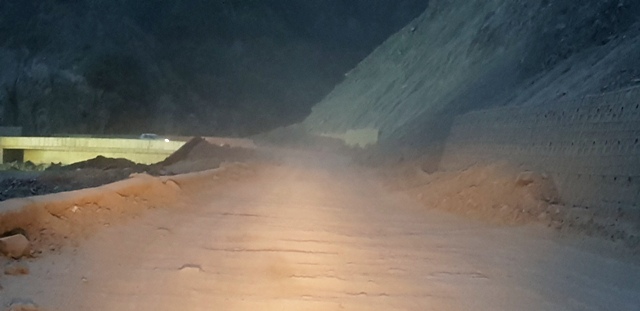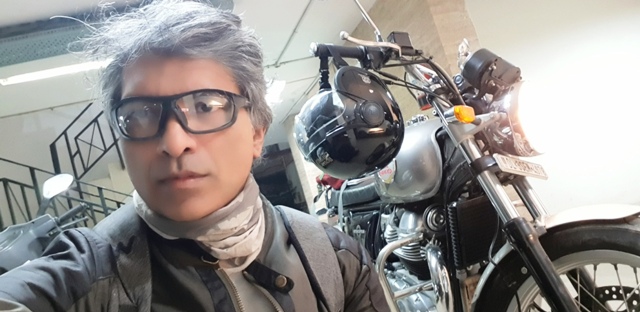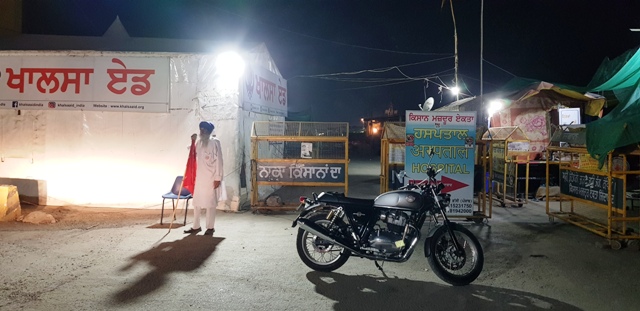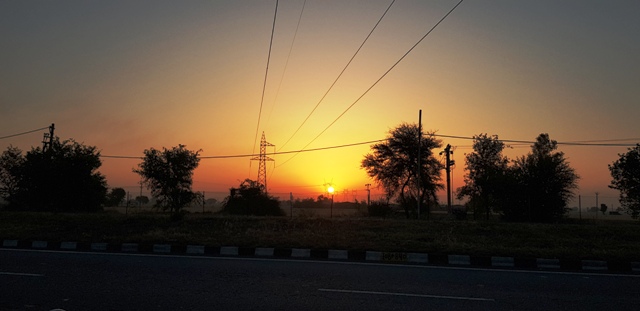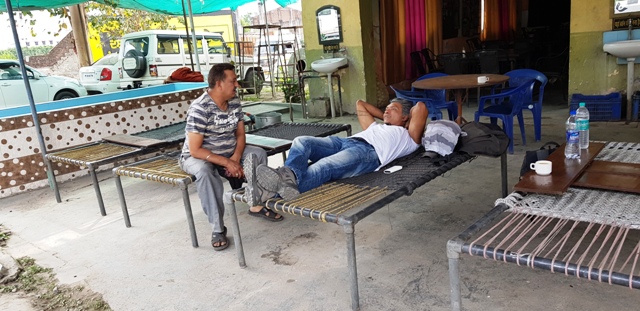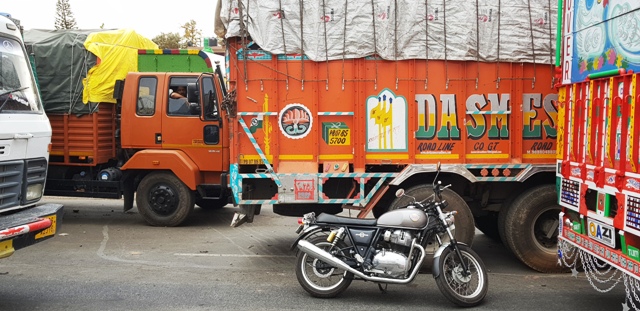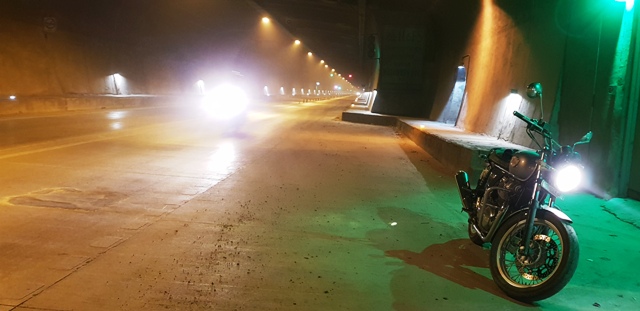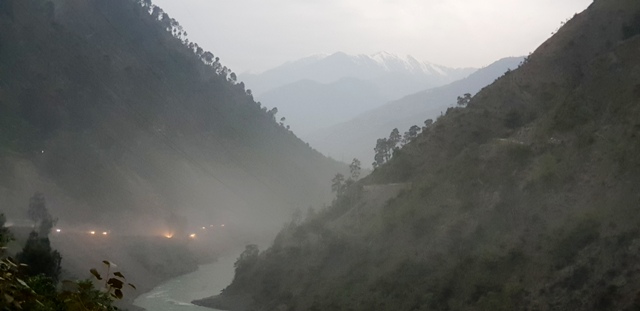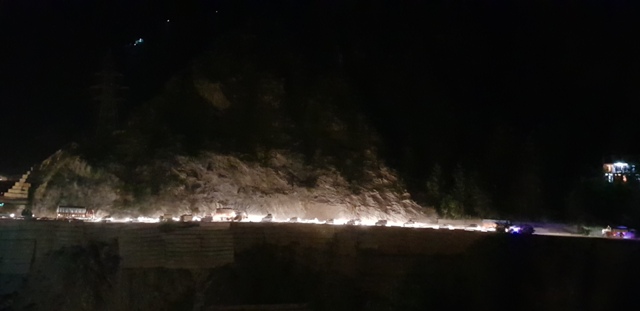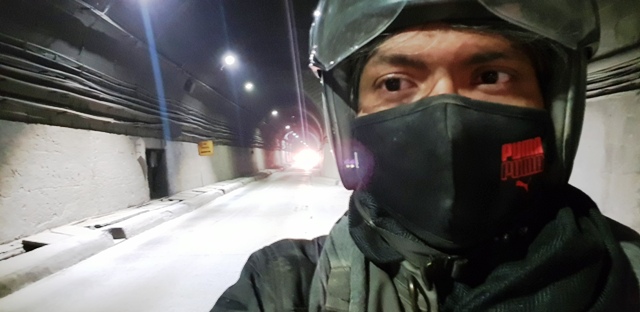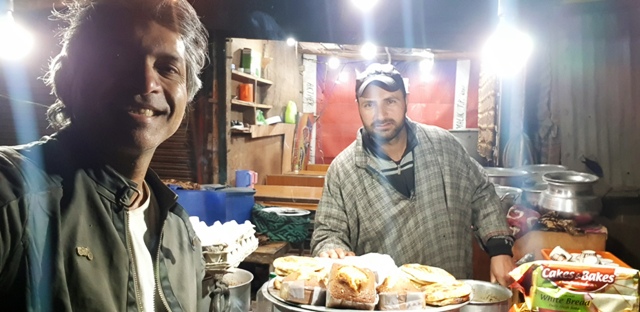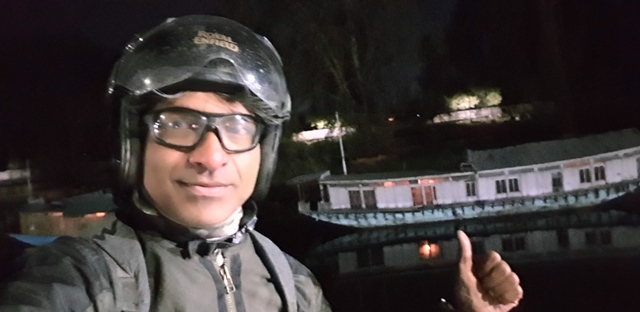The tunnel was leaking, then that’s how I think tunnels are supposed to be – with little ducts drilled through to act as pressure valves which in turn filters in the outside weather. They could be also the same ones through which the sun sends in vertical beams during daytime which falls on the tarmac like blinding little spotlights. The Chenani-Nashri tunnel bypasses the snow-bound upper reaches, cutting short the distance between Jammu and Srinagar. But going by what lay in store soon after the tunnel I knew those winding lanes between the tricky cirques and couloirs would have been lot better – and definitely more scenic from what I remembered. Opened four years back, there are cameras rolling inside the tunnel; soon as I stopped my motorcycle a voice boomed like Napoleon in Animal Farm that no vehicle was supposed to stop unless it was an emergency. A warm micturition away from the wintry dusk fast falling could surely be an understandable emergency.
Having left Delhi at 4 AM I was making good time despite a puncture and a late leisurely lunch, lolling over a charpoy at a roadside dhaba and shooting breeze with the cooks: they were both security guards at a hotel in Kalkaji in Delhi which had shut down following the lockdown since last year. Their culinary skills were acquired from watching colleagues in action in the kitchen and lending an occasional hand; they asked me whether I could put them on to any job anywhere in Delhi. The only restaurant owner I knew had closed down last year itself and was tending to ancestral farms in his Bihar village. I shared them my email and told them to send me a basic bio data with photograph; maybe my restaurateur friend will need hands as and when he opens shop. It is important to keep hope floating too.
Armed military personnel were redirecting traffic as I neared the Singhu border where the farmers’ agitation was going on; the early rising sons of soil had their morning banis on through PA systems. I had been there twice earlier in solidarity and was by now used to their effusive hospitality. An old man standing by the protest venue with a cheery mien and a flag asked me whether I would like to have some hot tea. Early March with the winter reluctantly curtsying away mornings were still misty cold and my clothes were slightly wet. A couple of army men emerged from the langar tent from where tea and salt biscuits were being served; walked past me nodding not very effusively at my sat sri akal. Irritated? I wondered. Without due reason it could be symptomatic of helplessness or inadequacy; after all, many agitating farmers had their sons and close kin in the armed forces. Sons were forced to cordon off fathers. Strange times we live in.
I had done the Delhi – Srinagar run of around 900 km over two days earlier on my Standard 500 Bullet. Much as we have licked plenty of daunting rides, the Standard 500 was a temperamental monster needing a lot of attention, sometimes getting upset for no good reason and getting into seizures – where the pistons expand from overheating, grow too big for the cylinder walls. Mercifully the next stage of this event – when the pistons would melt and lock the engine along with the rear wheel with a crepitating sound – had happened to me just twice including once stuck at a traffic jam in Delhi during the peak of summer. Then you ride for days, hard as hell, up buttes in More Plains and over post holes of Baralacha La, it is grinning, smirking ‘bring it on.’ The first time I rode the Leh, Ladakh circuit over the Khardung La with a small group of other riders, mine was the only machine which did the distance and 15 days of torturous motorcycling without a glitch.
Reaching Srinagar in one day had always been a goal fuelled by my own desire to ride under pressure – and timelines. I need to ride fast to be aware of my surroundings, to be circumspect, to think and meditate. No fancy cruiser bikes with swan-shaped saddlebags and music systems blaring into the open air for me; where I come from, two-wheelers with songs coming out are used by lottery ticket sellers. Nor those with high foot pegs and sloping fairings sporting fluorescent psychedelics even if they accentuate aerodynamics where you hunch over like an extension of the fuel tank. Thus the Interceptor 650, with a fairly upright riding position and the first motorcycle from the Royal Enfield stable worthy of the ‘bullet’ tag. My rides to Kerala and Kutch from Delhi before last year’s lockdown were under strictly set time frames; the original Pirelli Phantom tyres had to be changed at 10,000 km which was less than half of its expected life span.
The brown buildings of Karnal (150 km) looked hazy from atop the flyover, struggling to snap awake from its mythological connections. A good friend lived here who wanted to meet; a young professional who stayed with her conservative parents which meant having to explain leaving the house at 6 AM. On the other hand the shiny road changing hue from velvety black to gold with a slow sprinkling of gilt courtesy of the rising sun beckoned. You could see a full kilometre or more ahead which meant you could rev full throttle.
Wariness and worries disappear along stretches like these, there is no more anger only an ardent focus on both sides of the road for jaywalking people and animals. You are hurtling forward, a controlled missile knowing your abilities and targets well, leaning slightly forward. After hours of riding, maybe a scintilla of physical discomfort might seep in, then that too will disappear as you lean in a little more. Before you can delve into it you get busy deducing others’ movements and forging your own path with least resistance.
‘Honk ok please’ is the biggest highway myth – truckers are ensconced in their cabins usually with radio at top volumes that they cannot hear you. I rode in a truck once from Nainital to Nepal border – they are invariably drunk too but would brake if a piglet ran between their wheels. If you are overtaking through the wrong side, zip by, without honking. If through the right, flash beams and hold for a second to make sure he is keeping a straight line. Wrong side, I tell you, is faster. Sometimes the thumping of the engine is so somniferous that I sing at throat-cracking loudness to keep myself awake. In highways at high speeds you get away with a lot of things, bad singing is one.
Old trucks shed nails and other loose hardware like aged dogs fur. Most of the time it gets rolled over to the sides, lies safely tucked into between granites or sometimes gets entrenched between your tread. I was lucky that when it happened I was filling up and there was a puncture repair shop right next to the station. Endless cups of chai and glucose biscuits for refection flowed from the tea shop nearby, cigarettes were lit along with conversations with truck drivers whose amused Punjabi went over my head as did my pidgin Hindi confounded theirs. We then agreed to frown at the one-and-half inch long screw dislodged from my hind tyre. I wanted to ask them to shut their tool boxes tight before hitting the highway. After every time you face a setback, you feel less invincible and start out at sober speeds; I was back on the road after nearly two hours and rode gingerly eyes glued on the road for sharp objects. For a while.
Passing a blistering industrial Jalandhar, the road cut a grey ribbon across an ochre landscape, meandering now and then. It rose, banked and cut briefly back and then followed the direction steadfastly like a chastised child. Most of the morning there were small cottony clouds strewn like a careless throw of dice. Anticipating rains, I automatically reached back and pressed the side corner of my backpack where I keep a short rain jacket rolled for easy extraction. Though rains while riding can be a muggy affair, I wished for some relief from the parched region throwing up wavy mirages. The stifling humidity gave hope. I stopped to coordinate with the lab in Gurgaon which did the RTPCR testing for both me and my girlfriend who would be flying in from Delhi to Srinagar; the negative certificate being mandatory at the airport. Despite their pollicitation that it would reach us before noon that day it hadn’t and when the lab technician finally picked my call the sun had fried my brain and I spoke rudely hollering above the roll of the non-stopping truck traffic. Bad move considering the result was sent a full day later – and there was a lot of posturing at the Srinagar airport.
Pathankot at around 500 km is a little more than halfway and there is a drastic change in the scenery right from the turn off the highway. The bare plains are suddenly greener, large fields stretch far with border delineating underbrush, small ponds, lone inselbergs which usually mark the arrival of mountains in clusters and in this case, the Himalayas. The burning white of the sun peters out into a warmer tan, scattered rocks and loose sand mark the side of the road and a gibbous moon in the sky above.
I felt hungry and stopped by the wayside eatery manned by the erstwhile security guards. When you ride into a place there is so much earnest ignoring happening, except for a perfunctory glance acknowledging your arrival the cook looks busy, disinterested even. Earlier I used to make small talk soon as I walked in, now I just occupy the charpoy and shut my eyes. This is ice breaking at its finest – there is a happy quandary, whether to wake you or not. A large part of the cook’s work is to observe you and decide on the effort to put into making your food. It is this precise thinking why they are usually quiet and withdrawn – the rest of the work, the actual cooking itself, is automatic, they can do blindfolded. The chotu appears with an impressive list of food and you listen intently even though you knew since you left home that morning what you will be having. It is always roti bearing either potato or mushroom enmeshed, smashed. I would flip for paneer, cottage cheese any day but not on the road. The pickle and green chilli come with houseflies humming warning to keep off, better to heed.
The Jammu Police welcomes you to the ‘city of temples’ but not before you fill a ‘Covid declaration’ at the border – where you enter every detail including name, address and vehicle registration except your Covid status. Taking cues from the land’s leaders, optics had reached a nadir where nonsensical effort seemed to be the order of the day. Riding through Jammu city and finally exiting it felt like going round on a gigantic slide, one which finally defenestrates you at the foothills of majestic massifs. In the final rays of the setting sun their snow peaks glinted, demiurgic even in the dusk. As is my ritual I stopped my motorcycle and thought gratefully about a good day.
It was nearing 6 PM and I had been riding for 10 hours, averaging 70 km per hour – which meant I would be by the Dal Lake in under three hours and reach the homestay nearby where my girlfriend had checked into, lift her up though she hated it, making her squeal and open a bottle to my much-anticipated feat. The night, whenever I reached, would be still young. Unfortunately, the around 100 km after the Chenani-Nashri Tunnel was nothing short of brutal, namma hole country, where trucks stood unmoving fender to garish fender and you could feel the dust seep through your exposed skin pores and grate through your veins. It took me four hours to emerge from this nightmare and reach the Jawahar Tunnel from where Srinagar was around 80 km, or an hour. The road, Riyaz assured me, was like makhan, butter.
Riyaz ran one of the cafes that were thankfully still lit on the other side of the Jawahar Tunnel though it was close to 11 PM. Somehow it had gotten into my head that I had to be at the Dal Lake before midnight and I debated with myself whether to stop for tea or not. I was a grime scene, my bones were jarring and knees juddering and I had been singing loudly – this time to keep tiredness and a robustly encroaching sleepiness at bay. A simpatico, Riyaz refused to believe that I had left Delhi that morning instead he insisted that I was air dropped along with my motorcycle nearby. It takes three days by road to reach here, he said. Wrapping his head around my claims somehow he made the most buttery tea. Keeps you warm, he said. I gobbled down along with some homemade cakes. He insisted I spend the night at his house and kept lighting up his gas stove to warm my hands as we talked making me tarry longer. Just one of the many sockdolagers – a wonderment that continued into the Valley over the next fortnight.
I flew the rest of the way; an unmarked car followed me a little unnervingly till the first checkpoint. I was stopped at two heavily guarded posts marking turns to Anantnag and Pulwama. A Delhi registration motorcycle speeding through sensitive terrains understandably gives rise to questions. While a heavily armed trooper asked me questions, alert eyes over covered faces watched me from inside armoured cars. I have my own little routine here – I start off in English and then as if detecting their discomfiture I switch to Hindi and I am soon waved off. I imagine them doubling over with laughter soon as I am out of earshot. My loose grip of the language works both to adduce my credentials as a travel writer and comedy material. It works.
A minute before the stroke of midnight I posted an unflattering picture by the Dal Lake. Some guys still awake asked me if I was looking for a place to stay. Houseboats cluttered the water in decrepit darkness; on both my earlier trips I stayed on boats but since my girlfriend was allergic to diesel fumes we decided on a homestay a little removed from the lake. I traced the perimeter of the Dal twice before I could find somebody to direct me to the location where I was staying; along the thickly populated embankment settlements the GPS was going haywire. Two guys in a spanking new sedan directed me along a narrow path through a bunch of hovels. There is a CRPF camp on one side, I was told by way of landmark. Just as I was leaving I heard a woman say something from the backseat of the car. Two loud honks made me stop. The driver swung his head out and said,
“You must watch out for porcupines.”


